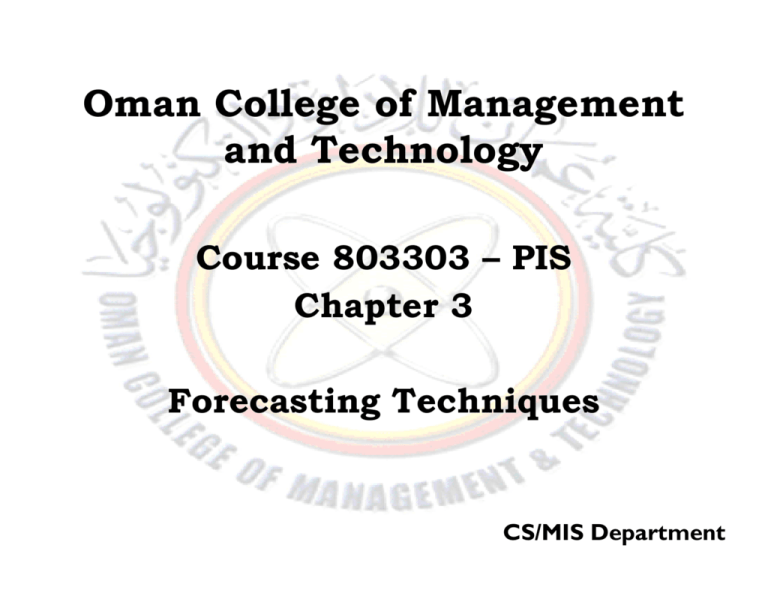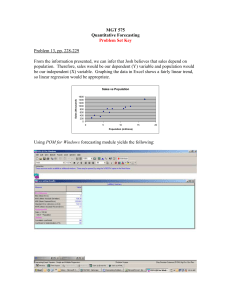Document - Oman College of Management & Technology
advertisement

Oman College of Management and Technology Course 803303 – PIS Chapter 3 Forecasting Techniques CS/MIS Department Definitions: Forecasting: a prediction of future events used for planning purposes. 2 Types of Forecasts Judgmental - uses subjective inputs. Time series - uses historical data assuming the future will be like the past. Associative models - uses explanatory variables to predict the future. 3 Time Series Forecasts 4 Trend - long-term movement in data Seasonality - short-term regular variations in data and related to certain time periods Irregular variations - caused by unusual circumstances (pattern) Random variations - caused by chance (Causality) Forecast Variations Irregular variation Trend Cycles 90 89 88 Seasonal variations 5 Forecasting Techniques Moving average Weighted moving average Exponential Trend and associative forecasting Pyramid 6 smoothing Forecasting Simple Moving Average Actual 47 MA5 45 43 41 39 37 MA3 35 1 2 3 4 5 6 7 8 9 n MAn = 7 Ai ∑ i=1 n 10 11 12 Exponential Smoothing Ft = Ft-1 + α(At-1 - Ft-1) Premise--The most recent observations might have the highest predictive value. Therefore, we should give more weight to the more recent time periods when forecasting. 8 Example of Exponential Smoothing Period 1 2 3 4 5 6 7 8 9 10 11 12 9 Actual 42 40 43 40 41 39 46 44 45 38 40 Alpha = 0.1 Error Alpha = 0.4 Error 42 41.8 41.92 41.73 41.66 41.39 41.85 42.07 42.36 41.92 41.73 -2.00 1.20 -1.92 -0.73 -2.66 4.61 2.15 2.93 -4.36 -1.92 42 41.2 41.92 41.15 41.09 40.25 42.55 43.13 43.88 41.53 40.92 -2 1.8 -1.92 -0.15 -2.09 5.75 1.45 1.87 -5.88 -1.53 Picking a Smoothing Constant Actual Dema Demand 50 α = .1 45 40 α = .4 35 1 2 3 4 5 6 7 8 9 10 11 12 Period 10 MIS 381 - Topic # 3 Common Nonlinear Trends Parabolic Exponential Growth 11 Associative Forecasting 12 Predictor variables - used to predict values of variable interest Regression - technique for fitting a line to a set of points Least squares line - minimizes sum of squared deviations around the line Fitting the line X 7 2 6 4 14 15 16 12 14 20 15 7 13 Y 15 10 13 15 25 27 24 20 27 44 34 17 Computed relationship 50 40 30 20 10 0 0 5 10 15 20 25 Linear Trend Equation Y Yt = a + bt 0 1 2 3 4 5 14 t a is the intercept & b is the slope. Since it is calculated with the variability of the data in mind, its formulation is not as straight-forward as our usual notion of slope. Calculating a and b n ∑ (ty) - ∑ t ∑ y b = n ∑ t 2 - ( ∑ t) 2 ∑ y - b∑ t a = n 15 Linear Trend Example t Week 1 2 3 4 5 2 t 1 4 9 16 25 2 Σ t = 15 Σ t = 55 2 (Σ t) = 225 16 y Sales 150 157 162 166 177 ty 150 314 486 664 885 Σ y = 812 Σ ty = 2499 Linear Trend Calculation b = 5 (2499) - 15(812) 5(55) - 225 = 12495-12180 275 -225 812 - 6.3(15) a = = 143.5 5 y = 143.5 + 6.3t 17 = 6.3 Forecast Accuracy Error - difference between actual value and predicted value Mean Absolute Deviation (MAD) Mean squared error (MSE) a systematic error of forecasting Tracking signal 18 Average of squared error BIAS: Average absolute error Ratio of cumulative error and MAD MAD & MSE ∑ Actual −forecast MAD = n 2 (Actual− forecast) ∑ MSE = n -1 19 Tracking Signal (Actual-forecast) ∑ Tracking signal = MAD (Actual-forecast) ∑ Tracking signal = ∑ Actual-forecast n 20 Tracking signal example Period Forecast Actual 1 2 3 4 100 100 100 100 MAD = 96 98 104 110 2 21 Cumulative Tracking Deviation Deviation signal 5 2.5 -4 1 0.5 -2 -1 -0.5 4 3 1.5 10 13 6.5 Track limit= ±4 Accuracy???? Product B Product A 30 30 25 25 20 20 15 15 10 10 5 5 Forecast Actual Forecast Actual • Which is more accurate? • Which can be fixed more easily? • Which is more “dangerous?” 22 “Radical” Thoughts on Forecasting: Forecasting is a Process Don’t Focus on Forecast Accuracy Focus on Bias – Stamp It Out 23 The Forecasting Process Outputs Inputs Current Customers New Customers Competition Economic Outlook New Products Pricing Strategy Promotions Bid Activity Management Directives Intra-Company Demand History (Data) Other Forecasts that are: Process 24 1. Reasoned 2. Reasonable 3. Reviewed Frequently 4. Represent the Total Demand Forecasts for Strategic Business Planning 25 Are used for long term broad based forecasts – capital expansion, new product line, merger or acquisition decisions. Usually use causal models and regression analysis Concluding Principles Forecasting models should not be more complicated than necessary. Simple models work just as good. Input data and output forecasts should be routinely monitored for quality and appropriateness. Information on sources of variation should be incorporated into the forecasting system. Forecast from different sources must be reconciled and made consistent with firm plans and constraints. 26







